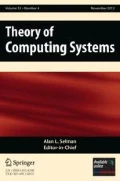Abstract
A transformation is presented which converts any pushdown automaton (PDA)M 0 withn 0 states andp 0 stack symbols into an equivalent PDAM withn states and ⌈n 0 /n⌉2 p 0 stack symbols into an equivalent ofn, 1⩽n<n 0. This transformation preserves realtime behavior but not derterminism. The transformation is proved to be the best possible one in the following sense: for each choice of the parametersn 0 + 1 stack symbols for any desired value realtime PDAM 0 such that any equivalent PDAM (whether realtime or not) havingn states must have at least ⌈(n 0 /n)2 p0⌉ stack symbols. Furthermore, the loss of deterministic behavior cannot be avoided, since for each choice ofn 0 andp 0, there is a deterministic PDAM 0 such that no equivalent PDAM with fewer states can be deterministic.
Similar content being viewed by others
References
A. V. Aho and J. D. Ullman.The Theory of Parsing, Translation, and Compiling, Vol. I: Parsing. Prentice-Hall: Englewood Cliffs, 1972.
Y. Bar-Hillel, M. Perles, and E. Shamir. On formal properties of simple phrase structure grammars, in Y. Bar-Hillel,Language and Information. Reading: Addison-Wesley, 116–150, 1964.
S. Ginsburg.The Mathematical Theory of Context-Free Languages. New York: McGraw-Hill, 1966.
S. Ginsburg and S. A. Greibach. Deterministic context-free languages,Information and Control 9, 563–582, 1966.
J. Goldstine, J. K. Price, and D. Wotschke. A pushdown automaton or a context-free grammar—which is more economical?,Theoretical Computer Science 18, 33–40, 1982.
J. Gruska. Complexity and unambiguity of context-free grammars and languages,Information and Control 18, 502–519, 1971.
M. A. Harrison.Introduction to Formal Language Theory. Reading: Addison-Wesley, 1978.
J. Hopcroft and J. D. Ullman.Introduction to Automata Theory, Languages, and Computation. Reading: Addison-Wesley, 1979.
M. O. Rabin and D. Scott. Finite automata and their decision problems, in E. F. Moore (ed.).Sequential Machines: Selected Papers. Reading: Addison-Wesley, 63–91, 1964.
M. P. Schutzenberger. On context-free languages and push-down automata,Information and Control 6, 246–264, 1963.
Author information
Authors and Affiliations
Additional information
This research was supported in part by the National Science Foundation under Grants MCS76-10076 and MCS76-10076A01.
Rights and permissions
About this article
Cite this article
Goldstine, J., Price, J.K. & Wotschke, D. On reducing the number of states in a PDA. Math. Systems Theory 15, 315–321 (1981). https://doi.org/10.1007/BF01786988
Received:
Revised:
Issue Date:
DOI: https://doi.org/10.1007/BF01786988




